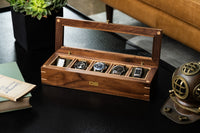What do the French Navy, Coco Chanel, Russian airborne corps, and Marcel Marceau have in common?
Not much. But one thing they do all seem to have an affinity for is a striped, blue and white shirt that has been a military and fashion staple for centuries. In Russian, this garment is called the Telnyashka, but in English it’s generally referred to as the Breton shirt, after the northwestern region (“Brittany”) in which the French Navy has historically been based.

IWC Aquatimer Cousteau Divers Limited Edition - IN THE SHOP
During the Middle Ages, striped garments were reserved largely for outcasts, the dying, and those on the fringes of society. However, this began to change in 1858, when the French government released a formal decree that called for a blue and white striped jersey as part of its naval uniform. Regulations governed the number of stripes (21, 20mm-wide white stripes and 21, 10mm-wide blue stripes on the body; 15 white stripes and 14 or 15 blue stripes on the sleeve) as well as how and where they were to be manufactured. Thus the wool-cotton blend marinière was born.
While it’s been speculated that the specific number of stripes is meant to correspond to the number of Napoleon’s victories — particularly over the British — this is difficult to confirm, given the method of counting has never been agreed upon. (Naval victories? Land victories? Both? During a specific war?) Regardless of their origin, the stripes provided a striking look that made a sailor easier to spot if he were to go overboard, and the boat-neck collar meant that it was easy to don and doff the shirt.

Blancpain Fifty Fathoms Milspec 1 - IN THE SHOP
In late 19th-century Russia, foreign sailors called up for review in front of a Russian admiral put the idea of the Breton shirt into the minds of Russian officials. Supposedly, Tsar Alexander II then included the shirt as part of a uniform decree in 1874, after which it began to proliferate amongst Russian military units of different branches. (More on that shortly.)

Coco Chanel in sailor stripes - (Image by 12West)
The Breton shirt was widely embraced not only by the French and Russian Navies, but by civilians as well, who encountered it as sailors took shore leave and brought parts of their uniform home with them into civilian life. In the 1920s, Coco Chanel, that most famous of French fashion luminaries, adopted the Breton shirt for civilian use, and it quickly became a fashion staple, permeating high society until artists as varied as Pablo Picasso, Audrey Hepburn, and John Wayne were seen wearing it.
Another famed Frenchmen who adopted the Breton shirt was Marcel Marceau, who survived the Second World War as part of the French resistance and went on to enjoy a career as the prototypical mime. Due perhaps to his embrace of the garment, the shirt was then seen, somewhat unfortunately — especially by Americans — as part of the wardrobe of the stereotypical Frenchman, where it’s often accompanied by a beret and a thin, curved mustache.

Tudor Submariner Marine Nationale 'M.N.' - IN THE SHOP
But back to the Russians. By 1912 the Breton shirt worn there had taken on the aspect of the modern Telnyashka, or vest, with stripe sizes standardized to a common width, doing away with possible symbolic interpretations purported to surround the French version. During the Second World War, as the Russians redeployed sailors to infantry units in order to meet the German threat during Operation Barbarossa, the Telnyashka became even more visible in Russian society.
Following the Allied victory, a Russian airborne general named Vasily Margelov campaigned for its adoption amongst his paratroopers; in 1969, the garment was officially adopted by military sanction. From here, it quickly spread throughout the Russian army to other units. Countries once or still allied to Russia that interacted heavily with its armed forces — including China, Belarus, Ukraine, Cuba, etc. — also began adopting the Telnyashka, which can be seen in the uniforms of those nations’ sailors.

Today, the Breton shirt is still a fashion accessory, piece of military kit, and old cliché. Available in various materials, sizes, colors, and cuts, it’s a versatile garment with a fascinating history that has managed to bridge cultural and geographical gaps to see widespread adoption all over the world. Commonly available from brands such as Armor-Lux and Saint James and relatively inexpensive, it’s still widely worn by sailors and fashionable people everywhere.












